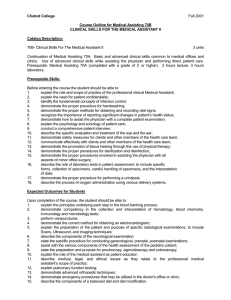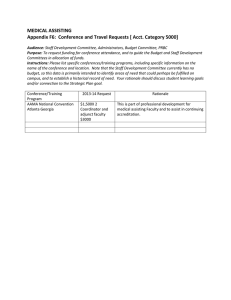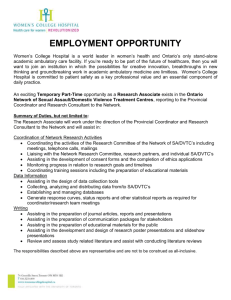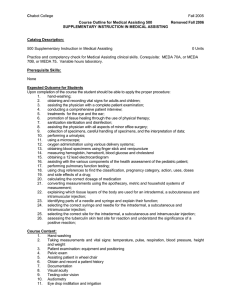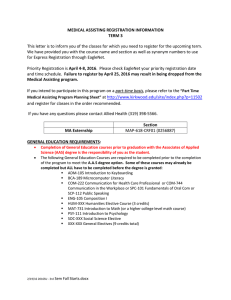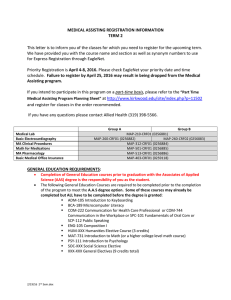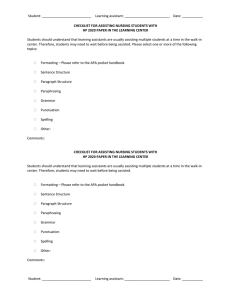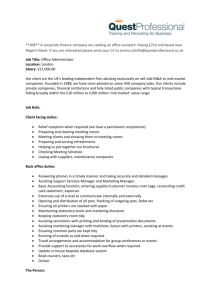Replaced Fall 2010
advertisement
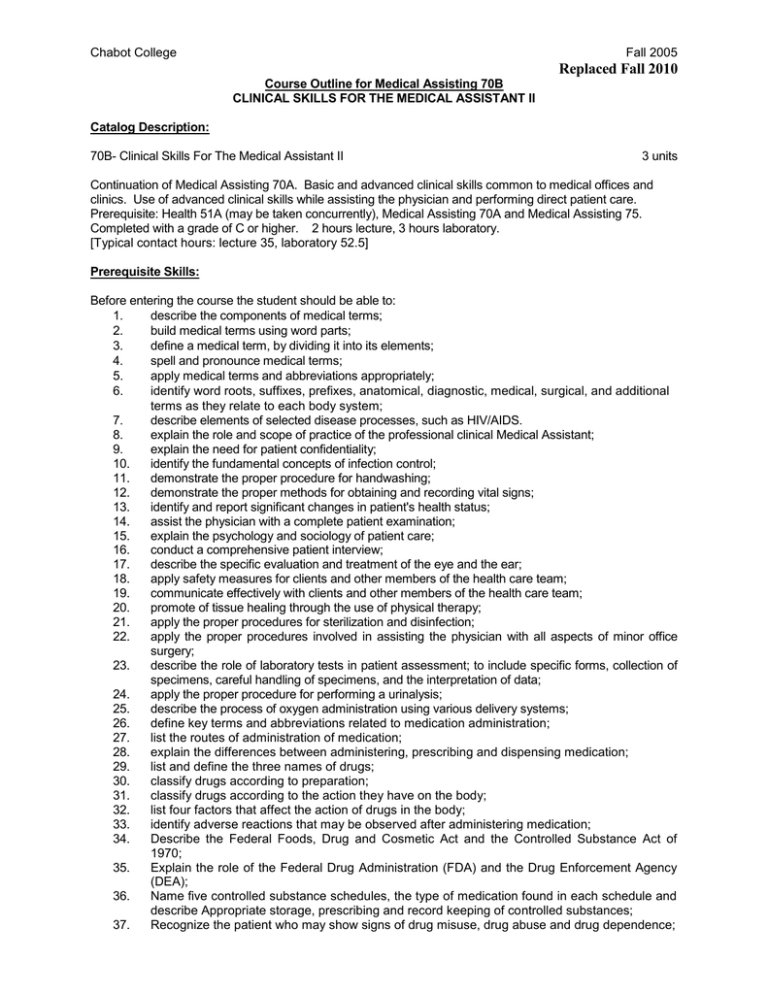
Chabot College Fall 2005 Replaced Fall 2010 Course Outline for Medical Assisting 70B CLINICAL SKILLS FOR THE MEDICAL ASSISTANT II Catalog Description: 70B- Clinical Skills For The Medical Assistant II 3 units Continuation of Medical Assisting 70A. Basic and advanced clinical skills common to medical offices and clinics. Use of advanced clinical skills while assisting the physician and performing direct patient care. Prerequisite: Health 51A (may be taken concurrently), Medical Assisting 70A and Medical Assisting 75. Completed with a grade of C or higher. 2 hours lecture, 3 hours laboratory. [Typical contact hours: lecture 35, laboratory 52.5] Prerequisite Skills: Before entering the course the student should be able to: 1. describe the components of medical terms; 2. build medical terms using word parts; 3. define a medical term, by dividing it into its elements; 4. spell and pronounce medical terms; 5. apply medical terms and abbreviations appropriately; 6. identify word roots, suffixes, prefixes, anatomical, diagnostic, medical, surgical, and additional terms as they relate to each body system; 7. describe elements of selected disease processes, such as HIV/AIDS. 8. explain the role and scope of practice of the professional clinical Medical Assistant; 9. explain the need for patient confidentiality; 10. identify the fundamental concepts of infection control; 11. demonstrate the proper procedure for handwashing; 12. demonstrate the proper methods for obtaining and recording vital signs; 13. identify and report significant changes in patient's health status; 14. assist the physician with a complete patient examination; 15. explain the psychology and sociology of patient care; 16. conduct a comprehensive patient interview; 17. describe the specific evaluation and treatment of the eye and the ear; 18. apply safety measures for clients and other members of the health care team; 19. communicate effectively with clients and other members of the health care team; 20. promote of tissue healing through the use of physical therapy; 21. apply the proper procedures for sterilization and disinfection; 22. apply the proper procedures involved in assisting the physician with all aspects of minor office surgery; 23. describe the role of laboratory tests in patient assessment; to include specific forms, collection of specimens, careful handling of specimens, and the interpretation of data; 24. apply the proper procedure for performing a urinalysis; 25. describe the process of oxygen administration using various delivery systems; 26. define key terms and abbreviations related to medication administration; 27. list the routes of administration of medication; 28. explain the differences between administering, prescribing and dispensing medication; 29. list and define the three names of drugs; 30. classify drugs according to preparation; 31. classify drugs according to the action they have on the body; 32. list four factors that affect the action of drugs in the body; 33. identify adverse reactions that may be observed after administering medication; 34. Describe the Federal Foods, Drug and Cosmetic Act and the Controlled Substance Act of 1970; 35. Explain the role of the Federal Drug Administration (FDA) and the Drug Enforcement Agency (DEA); 36. Name five controlled substance schedules, the type of medication found in each schedule and describe Appropriate storage, prescribing and record keeping of controlled substances; 37. Recognize the patient who may show signs of drug misuse, drug abuse and drug dependence; Chabot College Medical Assisting 70B, Page 2 Fall 2005 38. 39. 40. 41. 42. 43. 44. 45. 46. 47. 48. 49. 50. 51. 52. 53. 54. 55. 56. 57. Use drug references to find the classification, pregnancy category, action, uses, doses and side effects of a drug; Identify differences in administering medication to the pediatric patient and the geriatric patient; Identify the common drugs in the categories of vitamins, minerals, herbs, antibiotics, antifungal agents, antiviral, psychotropic, antineoplastic and immunizations; List the common drugs used for the eye and ear; Describe the common drugs used for treating conditions of the respiratory, cardiovascular, gastrointestinal, urinary, reproductive, endocrine, musculoskeletal, and nervous systems; List and explain the different parts of the prescription; Calculate the correct dosage of medication using the proportional method or formula method; Convert measurements using the apothecary, metric and household systems of measurement; List the six rights of medication administration; State the advantages and disadvantages of using the parenteral route of administration; Explain which tissue layers of the body are used for an intradermal, a subcutaneous and intramuscular injection; Identify parts of a needle and syringe and explain their function; Select the correct syringe and needle for the intradermal, a subcutaneous and intramuscular injection; Select the correct site for the intradermal, a subcutaneous and intramuscular injection; Read correctly the calibrations on the syringe and draw up the correct amount of medication; Explain the purpose of using the Z-track method of intramuscular injection; Explain the purpose of tuberculin skin testing; Assess the tuberculin skin test site for reaction and understand the significance of a positive reaction; Explain the principle underlying each step in the procedures for administering oral, parenteral medications; Describe the purpose and method for allergy tests. Expected Outcomes for Students Upon completion of the course, the student should be able to: 1. explain the principles underlying each step in the blood banking process; 2. collect and interpret hematology, blood chemistry, immunology and microbiology tests; 3. perform venipunctures; 4. demonstrate the correct method for obtaining an electrocardiogram; 5. explain the preparation of the patient and purpose of specific radiological examinations, to include Scans, Ultrasound, and imaging techniques; 6. describe the components of the neurological examination; 7. state the specific procedure for conducting gynecological, prenatal, postnatal examinations; 8. assist with the various components of the health assessment of the pediatric patient; 9. state the preparation and purpose for proctoscopy, sigmoidoscopy and colonoscopy; 10. explain the role of the medical assistant as patient educator; 11. describe medical, legal, and ethical issues as they relate to the professional medical assistant's scope of practice; 12. explain pulmonary function testing; 13. apply advanced orthopedic techniques; 14. apply emergency procedures that may be utilized in the doctor's office or clinic; 15. describe the components of a balanced diet and diet modification.. Course Content 1. 2. Blood banking Hematological blood tests: a. Hematocrit b. Hemoglobin c. Erythrocyte sedimentation rate d. Blood cell counts e. Differential white blood cell count Chabot College Medical Assisting 70B, Page 3 Fall 2005 3. 4. 5. 6. 7. 8. 9. 10. 11. 12. 13. 14. 15. 16. 17. 18. 19. 20. Blood chemistry tests a. Blood glucose b. Blood urea nitrogen c. Cholesterol d. Triglycerides Venipuncture Microbiology specimens a. Streptococcal testing b. Urine culture c. Wound culture d. Vaginal culture e. Gram staining f. Sensitivity testing Immunology a. Mononucleosis testing b. Streptococcal screening c. Rh factor d. Pregnancy tests Electrocardiography a. 12 lead EKG b. Rhythm strip c. Ambulatory monitoring devices Radiological, and other imaging examinations Pediatric examinations Gynecological examinations Prenatal and postnatal examinations Neurological examination Colon and rectal procedures Medical-legal issues Ethical issues Patient education Orthopedic care Pulmonary function tests Diet modification Emergency procedures Methods of Presentation: 1. 2. 3. Lecture/discussion Skills demonstration Audio-visual materials Anatomical models and drawings Assignments and Methods of Evaluating Student Progress: 1. 2. Typical Assignments a. Complete the graph of Pediatric height and weight on an age specific growth chart b. Complete laboratory tests on the correct requisition Methods of Evaluating Student Progress: a. Complete of clinical competencies satisfactory b. Take Quizzes c. Complete midterm and final examination Textbook(s) (typical): Fundamentals of Medical Assisting Text, Sue A Hunt, Saunders 2002 Fundamentals of Medical Assisting Student Mastery Manual, Sue A Hunt, Saunders 2002 Chabot College Medical Assisting 70B, Page 4 Fall 2005 Special Student Materials: Medical Assisting Student Handbook dress requirements KC – [U:\kc’document\course outline\MEDA70B.doc] Revised: September 2004
